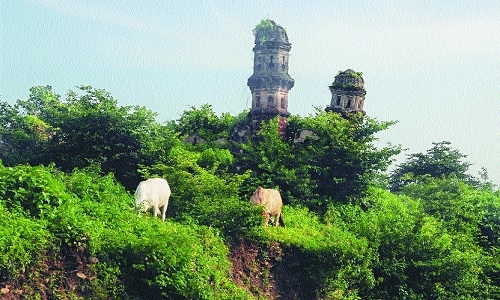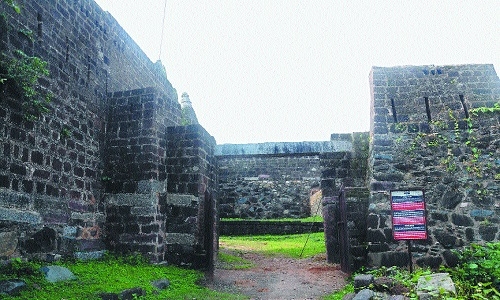VAIRAGAD FORTA STORY OF NEGLECT
| Date :03-Oct-2023 |

By Kartik Lokhande
As one enters the village Vairagad, also spelt as Wairagarh, one gets to see the concrete road snaking deep into the localities that have sprung up on the banks of the water channel. The concrete road misleads one to newer constructions. For, an old rugged pathway beyond the line of sight due to makeshift shops is what leads a curious visitor to what was once a seat of power -- Vairagad Fort. Sadly, today, barring the entrance, the ruins and overgrowth of vegetation tell the story of utter neglect. What was once known as a ‘fort’ in Armori tehsil of Gadchiroli district, has been reduced to remains of the past. The cries of the collapsing monument can attract anyone’s attention only fortuitously. The vegetational overgrowth overshadows even the remains of the fort, except for the area near the entrance. A glance at the wall along the pathway leading to the main entrance of the fort reveals that some repairs had taken place, as one can find disproportionate stones placed in an asymmetric arrangement to lend strength to the wall and prevent its collapse. However, there is no one to tell anything about this fort, at the entrance of which is a board stating that it is a ‘protected’ (!) monument.
The entrance is fairly in a good shape, weathering the history’s enemy called time. But, a glance upwards reveals sorry state of affairs as one of the minarets is tilted. Entering through the grand gateway leads one into what could have been a massive ground once upon a time. At present, one can see only vegetation through which some remains scattered here and there peep out to offer a glimpse of history and heritage. One has to stretch one’s eyes and look through vegetation to spot if fortification wall is intact. Two wells and a deep tank also are visible. One can see the images of Lord Ganesh and Lotus flower carved in stone. A millstone, statues carved in stone slabs, etc also are lying scattered in the fort amid vegetation. Sadly, not much is available on the fort, barring some old references in report of a tour in Central Provinces (1873-74) by J D Beglar, Assistant, Archaeological Survey, under the supervision of Major General A Cunningham, Director General, Archaeological Survey of India (ASI); Central Provinces District Gazetteers -- Chanda District (Volume-A, Descriptive, originally published in 1909); ‘Chandrapur Gadchiroli Jilhyache Puratatva’ by Dr R R Borkar.

Noted historian Ashok Singh Thakur, who has to his credit several books, and who is Governing Council Member of Indian National Trust for Art and Cultural Heritage (INTACH), offers some collective insight into the rich history of Vairagad Fort. “The fort is on the confluence of Khobragadi and Vairochana rivers. It was once the capital of Gond king Virat. The fort is surrounded by moat. “One finds mention of Vairagad in Hastigumfa stone inscriptions near Bhubaneshwar (Odisha) dating back to Second Century BC. This inscription mentions about Kaling Samrat Mahameghvahan Kharvel winning territory up to Krishna Venna, and marrying Princess Ghusita of Vairagad,” Thakur told ‘The Hitavada’. In Ninth Century AD, Nagvanshi Mana kings ruled Vairagad. Kurumprahoda, the first of the line, is said to have constructed the Vairagad Fort. In 13th Century AD, Yadavas of Deogiri also had taken possession of the fort. Later, Gond kings ruled here. “The fort’s construction reflects different styles because its possessors carried out repairs or fortification and made their own additions. Those who held the fort in different times included Nagvanshi kings, Gond kings, Bahamanis, Yadavas, Bhonsala, and the British,” Thakur said. The Mana princes’ names recorded in history include Kurumprahoda, who ruled Vairagad, Surjat Badwaik who fortified Surjagarh, and Gahilu who built the fortress of Manikgarh. Vairagad was the biggest fort of Nagvanshi kings in Vidarbha region. This fort has moat, which is a unique feature. The Mana or Nagvanshi kings of Vairagad were superseded by the Gond dynasty. The British-era records cite Gond tradition and state that there arose among the Gonds a man named Kol Bhil, who gathered Gond people and took possession of the fort and started ruling.
Though the history of the Vairagad Fort is rich, Thakur lamented, it needs better care. Pitching for better care and repairs, Thakur said, “If vegetation is not removed carefully, because it is deep-rooted now, the cracks in fort wall will widen, eventually causing greater damage to the structure. The minarets must be repaired, as they are tilted and can collapse anytime, damaging other remains of the fort.” Unfortunately, when there is no one to clear the vegetation, less said the better about the fort’s upkeep. As one leaves the fort with a heavy heart, and reaches the junction of the old pathway and concrete road in village, one is greeted with local elders. “You came all the way to visit the fort? What is there to see? It is all a dilapidated structure, waiting to die its own death....” says a dhoti-clad elder sporting white beard. Is Vairagad Fort dying its own death? Well, the question about the glorious past’s survival has to be answered by the forward-looking present...